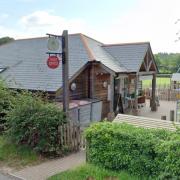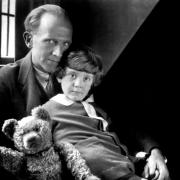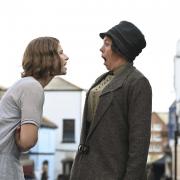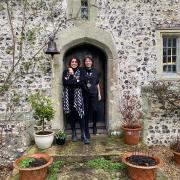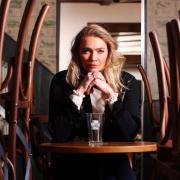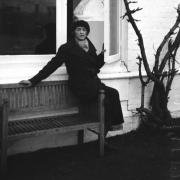In a corner of St Wulfran’s churchyard in Ovingdean, east of Brighton, is the neglected grave of an extraordinary woman – Helena Normanton. She was the first woman to practice as a barrister in England, a considerable achievement considering the legal profession was totally male dominated in the 1920s.
The fact that she overcome patriarchy, her own family struggles and society’s prejudices to reach the top of her profession and fight for women’s rights shows just how resilient she was.
Born into a working-class family in London’s East End in 1882, Helen’s parents separated when she was four, and her father, a piano maker, was found dead shortly afterwards in a railway tunnel, a possible suicide.
The family moved to 4 Clifton Place in Brighton’s Montpelier district, where they set up a grocery business, and let out rooms in their home. Helena was an academic child and went to school in York Place, which would later move, and become Varndean School for Girls.

Helena realised she wanted to become a lawyer – an impossible dream back then for a woman – when she accompanies her mother to a meeting with her solicitor. Frustrated that the woman couldn’t grasp the detailed conversation, the condescending solicitor asked Helena if she understood what he was saying. She said she did, causing the solicitor to comment that she was, ‘quite the little lawyer.’ At that moment, the idea was fixed in her head. Years later, in her book, Everyday Law for Women, published in 1932, she would write: ‘I still do not like to see women getting the worst end of any deal for lack of a little elementary legal knowledge which is the most common form amongst men.’
But her ambition was dealt a terrible blow when her mother died and she had to leave school to look after her younger sister.
It wasn’t until she was 19, and moved to 11 Hampton Place, Hove, a boarding house run by an aunt, that she could resume her education. Two years later she did a teacher training course at Edge Hill College, Liverpool, in 1903, then went on to the University of London where she gained a first-class degree in modern history.
Helena taught in London and Glasgow, but became increasing aware of the many issues relating to women’s rights. In the early 1900s, women were still regarded as men’s property. If a marriage broke down it was usually assumed to be the woman’s fault and divorce was fraught with difficulties. A huge disparity between men’s and women’s pay existed at every level. A Tax Act stated that women who married were ‘incapacitated persons,’ to be listed alongside infants and lunatics. And, of course, women couldn’t vote.
Helena began campaigning for social reforms and soon became a compelling speaker. She joined the Women’s Social and Political Union, led by Emmeline and Christabel Pankhurst, but dissatisfaction with their leadership led to a splinter group forming, the Women’s Freedom League, in 1907, which she joined.
Helena began writing and circulating pamphlets, mostly highlighting inequality of wages. One, titled ‘Sex Differentiation in Salary,’ argued for equal pay for equal work. A later one, in 1918, stated: ‘During and after the war many soldiers’ wives and widows became the breadwinners for families. Should they be paid according to their sex or their work?’
She wanted to help women from inside the legal profession but there was no female role model to follow, the legal profession being entirely populated by men – and most wanted it kept that way. Women had tried to enter the legal profession before, to no avail.
Her 1918 application to become a student at Middle Temple, in London, one of four ‘Inns of Court’ whose members could practice as barristers, was rejected out of hand, purely because she was female. Her letter of application pulled no punches: ‘I believe that the sex-exclusiveness of the legal profession is doomed. Women won’t stand it, and men, who have been learning a great deal lately about women’s capabilities, will not tolerate it either.’
The rejection led to one of her most spirited acts: lodging a petition against the decision in the House of Lords. While awaiting the outcome, she reapplied, but was turned down again. It seemed pointless to continue, but then luck suddenly was on her side - 1919 saw the passing of the Sex Disqualification Act, which stated women could now pursue careers previously denied them, such as the legal profession. A new application was accepted just hours after the Act was passed and Helena became the first woman to be admitted as a scholar to the bar. Her student card was dated 24 December, 1919. She sailed through her studies while meeting Gavin Bowman Watson Clark, an accountant, who she married in 1921.
The first woman to qualify and be ‘called to the bar’ was Ivy Williams, an Oxford academic, in May 1922, with Helena becoming the second in November that year. But as Williams didn’t become a serving barrister (she went on to teach law), Helena is regarded as the first practicing barrister in Britain.
Of course, it wasn’t plain sailing. Other lawyers gave her the cold shoulder, and she was forced, initially, to take on cases others turned down, usually poorly paid and ‘deemed suitable for women.’
But Helena was a force to be reckoned with and she had a number of ‘firsts’ in her career. She was the first woman barrister to win a divorce for her client, first to prosecute in a murder case, and the first to lead a trial in America. She became the first female consul in both the High Court of Justice (civil cases) and the Old Bailey (criminal). In 1949, with Rose Heilbron, Helena became the first woman to be appointed as King’s Counsel, becoming one of the leading lawyers in the country.
During all these successes, she insisted on keeping her maiden name, which raised more than a few eyebrows. In 1924, when travelling to America for a lecture tour, she became the only married woman at that time to be issued with a passport in her own name, not her husband’s. She said of this – ‘Anne Boleyn did not change her name even though she married a king. He at least had the decency to leave her with her own name even though he took her head.’
She still maintained her interest in women’s rights. In 1938, with Vera Britten and others, she founded the Married Woman’s Association. This sought a whole a host of radical reforms, including absolute financial equality in a marriage and both parents having equal guardianship rights over any children.

One blight on her later career was how her prolific writing output, public speaking and social campaigning came to be seen as self-promotion, something forbidden by legal protocol, eventually prompting disciplinary proceedings. This may have been why she never became a judge.
Helena retired in 1951, living in London, but she never forgot her seminal days in Brighton. A reunion of ‘old girls’ at Varndean in 1947 saw her as guest of honour and when an appeal went out to fund a University in Sussex in 1956, she was the first to donate. On her death, the following year, more funds were bequeathed to the project, and the University was founded in 1961.
The struggle she initiated for equality still goes on. While some 33% of self-employed barristers in Britain are women, only 13% are Queen’s Councillors. When it comes to judges, about a third of court judges are women. In the highest court in the land, the Supreme Court, three out of twelve justices are women.
Yet Helena’s personal legacy continues. In 2017, Sussex University created an international postdoctoral fellowship in her name. In 2019, barristers’ chambers at 218 Strand, in London, were renamed Normanton Chambers. The following year saw barrister Karlia Lykourgou, set up the first firm specialising in women’s courtroom outfits, with the business called ‘Ivy and Normanton,’ Ivy, from Ivy Williams, and Normanton, from Helena.
And Helena’s esteem today? In a history project of 2019, supported by the Law Society and Bar Council, named ‘First Hundred Years,’ it stated that, ‘Normanton should be to women lawyers what Neil Armstrong is to astronauts. And this is no exaggeration.’
A blue plaque was unveiled on 4 Clifton Place, her Brighton childhood home, in June last year, following a campaign led by two local teenagers, Izzy and Sophia Kilburn.




